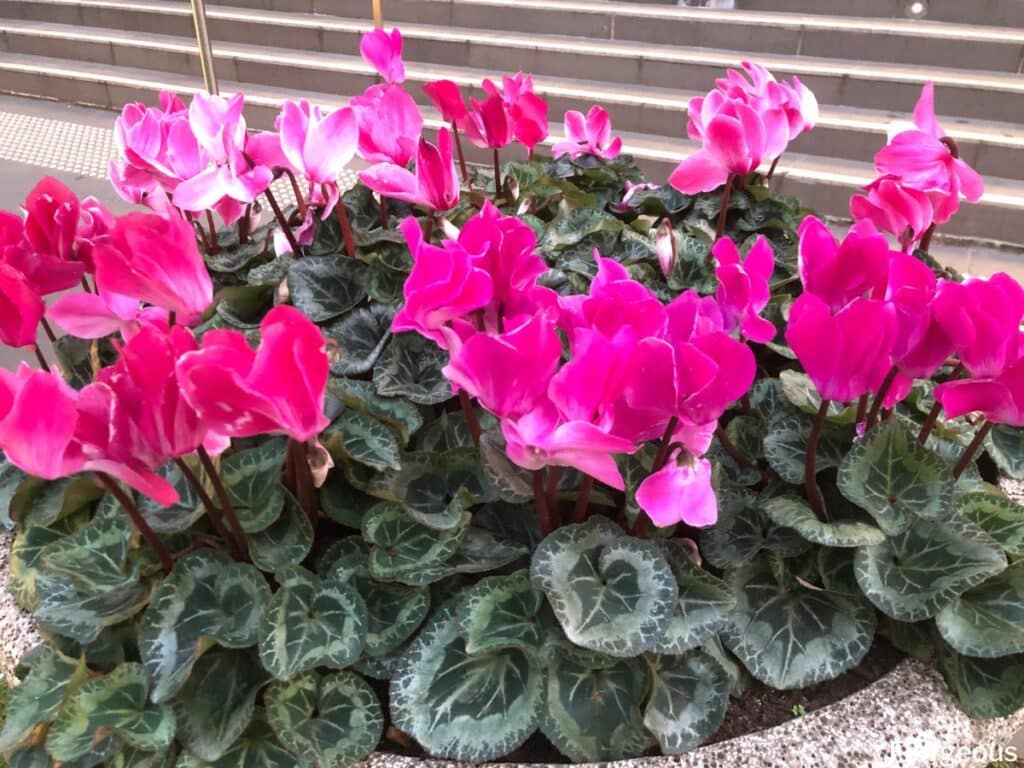Cyclamen, also known as Persian violet or Cyclamen persicum, is a flowering perennial that is native to the Mediterranean region. The name is derived from the Greek word for “coil,” a testament to how the flower curls up around the seedpods.
Though cyclamen can thrive in many different climates, they require some special care and attention.
One of the most common issues that cyclamen owners face is yellow leaves.
So what causes this problem and how can you fix it? Let’s take a look at some of the most common causes of yellow leaves on this plant.
Why Are My Cyclamen Leaves Going Yellow?
There are a few reasons why your cyclamen leaves might be turning yellow, from soggy soil to spider mites.
Let’s take a closer look at some of the most common reasons why the leaves of your indoor and outdoor cyclamen alike might be dying back.
Too Much Direct Sunlight
Growing cyclamen plants can be delightful in the household, yet their beauty is often reduced by the leaves turning yellow. In some cases, this can be caused by too much direct sun for potted cyclamen plants.
Sunburn can not only make leaves turn yellow, but it can also cause unsightly yellow spots or crispy brown leaves as well.
Adding a shade cloth or moving your potted cyclamen to a filtered light area are potential solutions.
Cyclamen plants were meant to exist under light filtered coverings of trees and shrubs, so it’s important to remember that while they’re beautiful indoors, they’re designed with outdoor conditions in mind. It’s best to grow these plants in window boxes or garden beds in full sun.
If that’s not an option, put your pot in direct sunlight. Just make sure you don’t put the pot in a north facing windowsill. Even in the summer, this likely won’t provide the ideal temperature and sunlight conditions for your plant.
Make sure you choose plants that are meant for your specific region and setting. If you want an indoor variety, choose cyclamen varieties that are better suited for containers and indirect light.
Otherwise, sow seeds directly outdoors to make sure your plants stay healthy and to avoid any potential yellowing leaves.
Wet Foliage/Excess Water
Yellowing cyclamen leaves are a common occurrence in the winter, when we tend to over water and crowd our other houseplants. This can cause a lot of distress for avid gardeners, who want to be able to grow all sorts of different flowers and plants.
Wet foliage is one of the most frequent causes of yellowing cyclamen leaves, as well as other common houseplants.
To prevent this unfortunate fate from befalling your favorite flowering friends, make sure you keep a regular watering schedule and don’t let the soil get too soggy before you consider watering again.
Improper Watering
Summer months can be challenging for a cyclamen growing in a pot as well as outdoors, since it requires very specific cyclamen care to thrive in the warm temperatures. One common problem with the cyclamen is yellow leaves caused by improper watering practices.
Overwatering can cause root rot and leaves to turn yellow on your cyclamen plant. This is due to not enough oxygen reaching them. Underwatering will dry out the soil and cause the leaves to turn yellow and crisp up as well.
Therefore, it’s important to make sure you’re watering only when the soil is dry, and making sure your cyclamen never sits in a puddle of water.
Cyclamen Mites
Unfortunately, cyclamen leaves turning yellow can sometimes mean that these white flowers have been attacked by cyclamen mites. Inspect the cyclamen pot carefully to see if this might be a problem.
These tiny pests are usually seen turning the plant’s newly emerging leaves yellow, and then causing dead flowers and dying leaves to drop off or turn brown.
Too-Warm Temperatures
Too-warm temperatures may be the cause of this change, which could lead to stunted growth or even a complete lack of blooms.
For these vibrant plants to thrive, they need cool days and nights, so be sure to give them the ideal home by making sure ambient temperature hovers around 60°F.
Excess Fertilizer or Lack of Nutrients
One common reason for its leaves turning yellow in many species is due to too much or too little fertilizer.
A lack of nutrients can be taken care of by adding some very light fertilizer as long as it is not added in excess.
On the other hand, when there is excess fertilizer added to the soil, it can cause a buildup of salts that can damage the roots and cause the leaves of your formerly vibrant cyclamen to start looking droopy and yellow.
Fungal Infections
Fungal infections can also be a culprit behind yellowed leaves on cyclamens. These infections are usually caused by overly humid conditions or waterlogged soil.
To prevent fungal infections from occurring, keep your plant in an area with good air circulation and don’t let it stand in water for too long after watering it.
The Most Common Cause of Yellowing Cyclamen Leaves? They’ve Just Gone Dormant!
It’s often a worry when the leaves of a beloved cyclamen plant begin to yellow, but this is typically not due to disease or other issues. Instead, yellowing leaves are usually a sign that the e plant has decided to go dormant – which is actually a natural process!
When this happens, stop watering your cyclamen and let it sit until new growth buds appear on the crown of the pot.
You may also notice that some of the foliage will dry up and fall off, however when you resume watering, fresh new growth should start in due time. Typically, dormancy occurs in the summer.
There’s not much you need to do to get your cyclamen pot through the summer dormancy. Just continue watering and wait for it to return to blooming in a few months!
Should I Remove Yellow Leaves From Cyclamen?
The decision on whether or not to remove yellow leaves can be quite challenging.
While taking off discolored foliage can help reduce damage to the remaining green parts of the plant, if taken away too soon, it may even impede blooming and growth.
Depending on how damaged the leaves are, you may be better off waiting until winter has finished before lightly trimming anything. Give the leaves a sharp tug rather than pruning to remove them from the base.
With a sweet fragrance and a gorgeous appearance, cyclamens are beautiful plants that can brighten up any room—but they do require some special care and attention! Pay attention to these tips to keep your plant looking great.
If you grow cyclamens outdoor, check these cyclamen companions to grow together.
See more: Meaning and Symbolism of Cyclamen Flower







